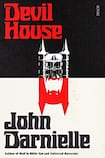
John Darnielle’s Devil House confronts something that true crime readers, and authors, would prefer to ignore: the cost of their morbid fascinations. The fourth novel by the author and frontman of the Mountain Goats follows a writer, Gage Chandler, who moves to the small town of Milpitas, California, buying and occupying the eponymous “devil house” in order to write his next bestseller on its grisly history. The murders that occurred in the 1980s at this place, a roadside porn shop abandoned by its owner, were drafted into the Satanic Panic thanks to elaborate, occult-inspired graffiti found at the scene of the crime.
What begins as a satire on crime writing evolves, quickly, into a tapestry of stories within stories. Darnielle returns here to themes from past works, including Wolf in White Van and his immersive, unexpectedly moving novella on Black Sabbath’s Master of Reality, narrated by a boy trapped on a psychiatric ward thanks to his love of Ozzy Osbourne. Devil House follows a set of similarly lonely young men who seek refuge in art – art that is consequently disastrously misunderstood.
Dangerous
This idea of creativity as both transformative and dangerous ripples through Devil House, infecting Chandler as he pieces together his plot. His is a similarly lonely life, spent recreating crime scenes and thinking himself into the minds of killers. Gradually, he loses control of his own narrative; it’s interrupted by voices, including a letter from the mother of a murder victim, and a passage composed in the second person, detailing the hours before a woman commits crimes that will seal her name in infamy. The reader’s attention is torn; as soon as this novel finds solid ground, it swerves away to another era, another voice, or even, at one point, another style entirely, lapsing into gothic script and Early Modern English in order to tell the story of two (imaginary) adolescent knights.
Devil House is likely not for everyone, perhaps not even all of Darnielle’s fans. But it’s courageous in its strangeness and sincerity, its formal ambition and the beauty it locates in culture’s forgotten, unloved outposts. For those willing to tolerate its tricks and its Nabokovian nesting-doll of a plot, Darnielle’s lost world of lost boys is a comforting place to be – all the more so for the danger looming beyond its castle walls.












